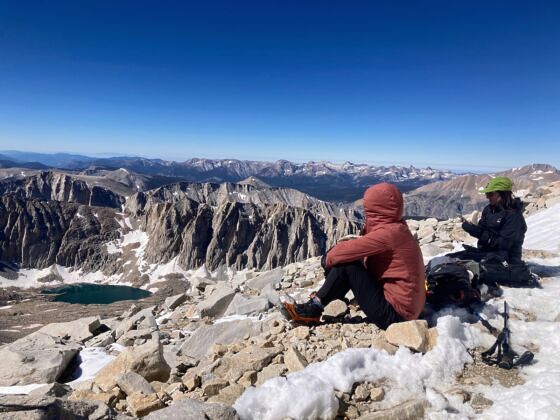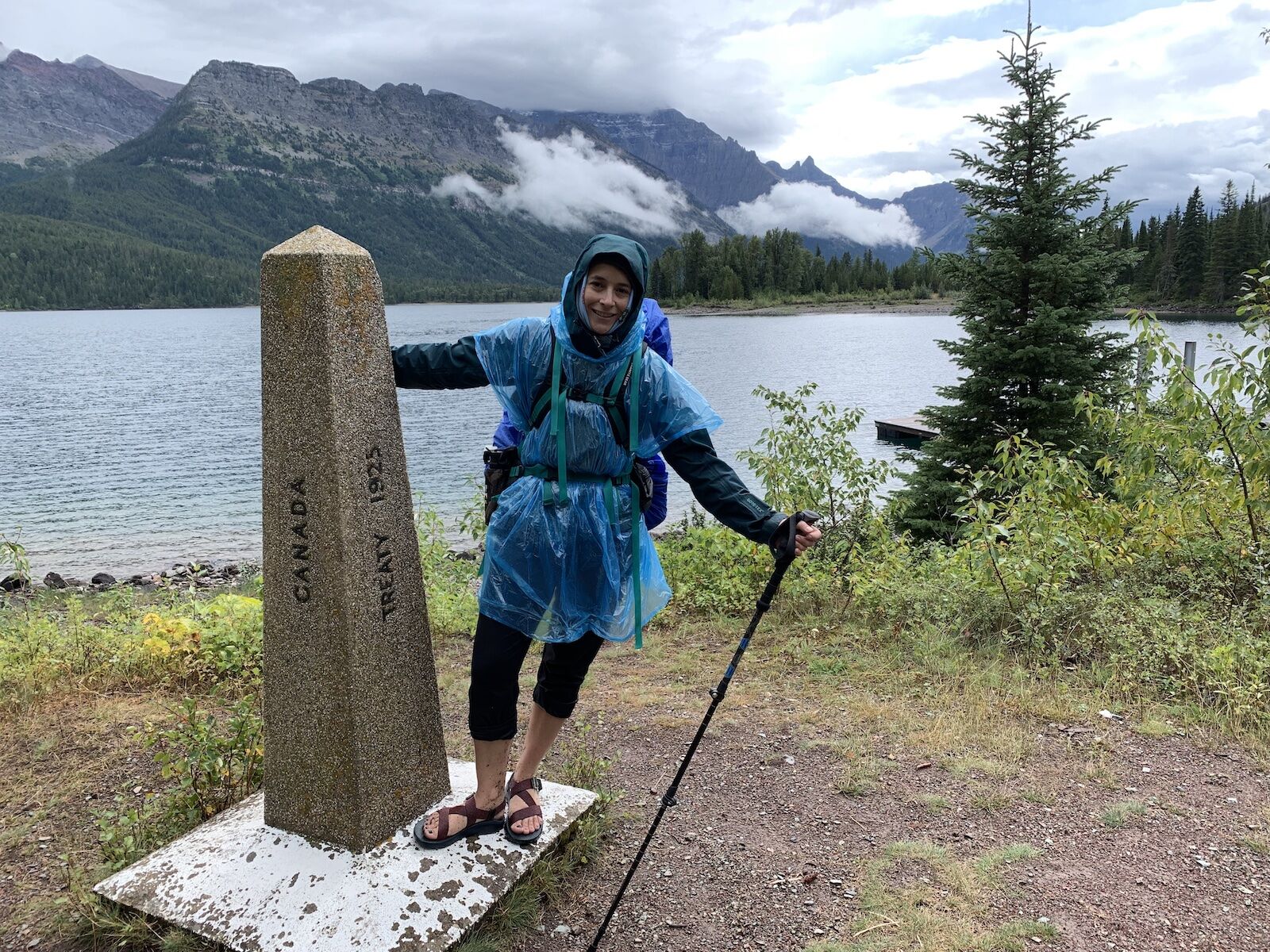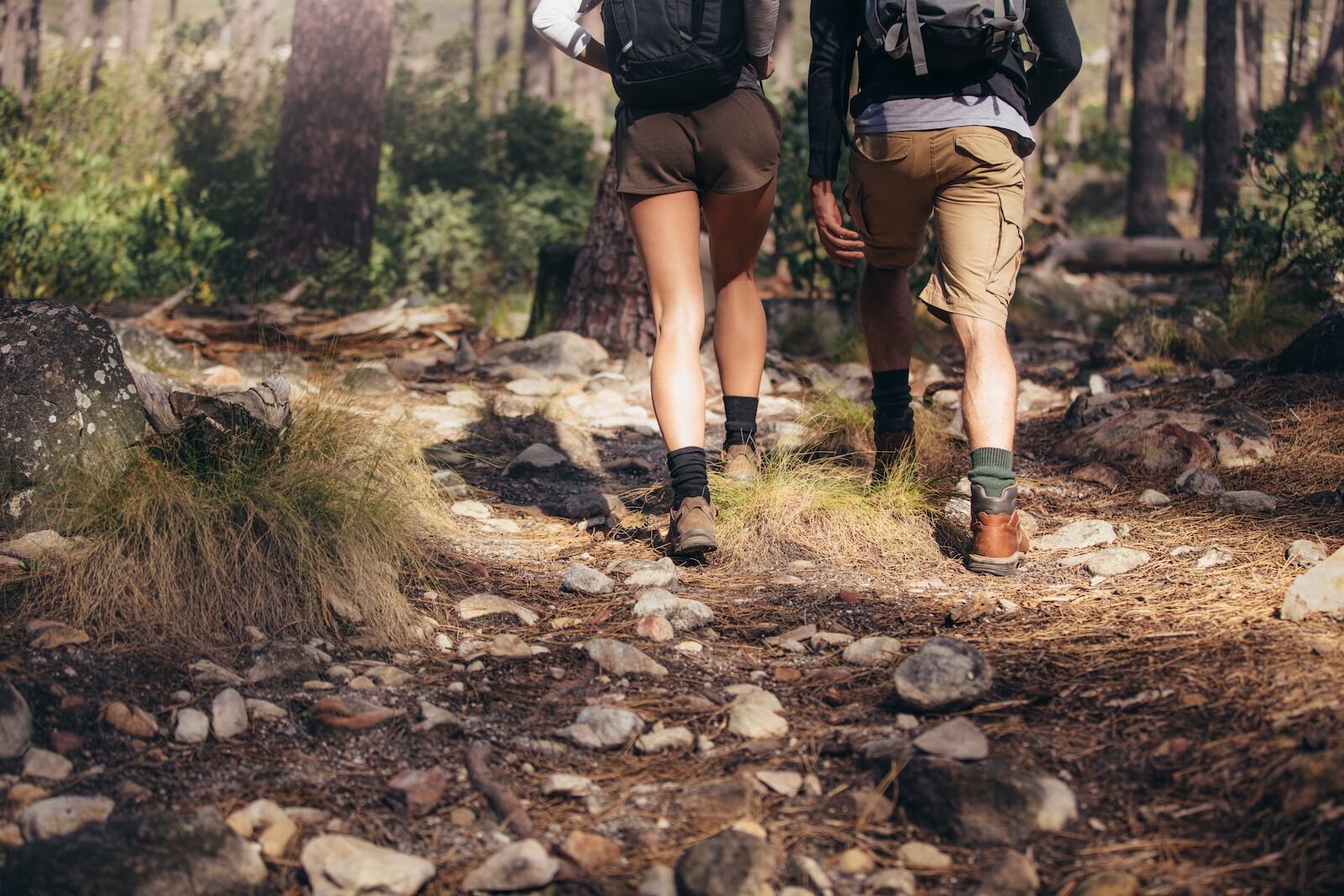I’ve been a travel writer for many years, writing articles and stories for people traveling for everything from quick overnight trips to epic bucket-list adventures. Obviously, that means I didn’t have too much work during 2020, when state and national borders closed and everyone stayed home during the start of the COVID-19 pandemic. So I leaned into my other passion: the mountains. I pitched and was commissioned to author a hiking guide to Lake Tahoe (published in 2021). It was my first solo publication but third bylined publication, following contributions to the Encyclopedia of Journalism and Lonely Planet’s Sustainable Escapes guide.

I'm a Published Guidebook Author. Here's Why You Shouldn't Trust Hiking Trail Reviews.

The author hiking across the US/Canada border through Montana (and looking fashionable in the process). Photo: Suzie Dundas
I’ve been an avid hiker since college and have hiked everything from The Narrows in Zion National Park to the Continental Divide Trail from the US into Canada to the “Teeth of Navarino,” the southernmost backpacking route in the world. By now, in my mid 30s, I consider myself an expert hiker, meaning that I’m experienced and knowledgeable about many types of trails, trail conditions, and planned and unplanned situations that can arrive in the great outdoors. So please, please believe me when I say this: online trail reviews are mostly BS. Relying on trail reviews to prepare for a hike is good way to set yourself up for failure.
Here’s why that is, and what you should look for instead.
Trail ratings are entirely subjective

The hike to the base of the Torres del Paine in Patagonia is harder than most hikes in the park, because it’s longer and steeper. But how hard? That depends on you. Photo: Suzie Dundas
For some people, a two-mile walk across desert terrain is as tough as it gets. Others are able to bang all sections of the 2,650-mile long Pacific Crest Trail in three months. And both types of people leave leave online reviews.
Words like “easy, “hard,” and “steep,” or phrases like “not well-marked,” “hard to follow” or “obvious break in the trail” are also very subjective. And they’re so overused that they really have no meaning. What’s hard to one person is easy to another.
Some people like to try to quantify their experience before giving their feedback, as if they need you to trust that they know what they’re talking about. The problem is most of these people use subjective words to qualify themselves. Terms like “fit” or “active” mean absolutely nothing, and what does being a “frequent hiker” mean, anyway? Even giving exact numbers doesn’t matter. I don’t care if someone does two hikes a month or hikes 300 miles year, unless I know all the details of those hikes and that person’s hiking levels.
Add on the fact that fitness and energy levels can change day-to-day — I hiked California’s Mount Whitney with exactly no training, but I sometimes get out of breath walking up the hill in my backyard — and it’s easy to see why subjective words in reviews are totally worthless.
Further, let’s say you know for a fact that someone is a young, fit person, who hikes regularly at least 20 miles a week. Well, that’s great — but what kind of terrain are they used to? Do they have knee problems, and struggle with downhill sections? Are they used to hiking at sea level, but are reviewing a trail that starts at 6,200 feet high? Heck, were they wearing the right type of shoes? Did they use hiking poles? Will you use hiking poles?
A lot of people just like to brag
You’ll find two kinds of reviews online, generally: short reviews with basic feedback, perhaps about trail conditions such as snow patches or stream crossings, and reviews from people who think they’re the Michaelangelo of AllTrails reviews.
The later tends to brag about their own abilities, oversell the difficulty or the easiness of the trail to make themselves look good, and will often dole out advice as if it’s unimpeachable fact; “you must wear hiking boots,” “there’s no way it could ever take you more than an hour to hike,” “older hikers won’t be able to manage.” As with subjective phrases and superlatives, so too are most of these reviews purporting to be helpful and thorough actually useless.
The info you should pull from online trail reviews

Check trail conditions ahead of time can help ensure your planned hike doesn’t turn into an unexpected snowshoe. Photo: Suzie Dundas
There are three main pieces of information you can rely on from online trail reviews: trail condition reports, photos, and measurable data.
“Trail conditions” refer to conditions along the trail at any given point in time, which sounds obvious, but can be trickier than it sounds. Trail conditions includes factors like how much water or snowmelt is on a trail (particularly helpful in high-elevation areas where trails are covered in snow until late spring), whether any sections of the trail are destroyed or in need of repair, how deep water crossings are, and how dry or dusty a trail is (particularly helpful in drought-prone areas, like California’s Sierra Madres). To be helpful, trail condition reviews should always list the date the person hiked the trail, which can help you know what you might encounter if you hike it around the same time and date.
Photos are easier to understand. Spend time clicking through reviewer photos if you’re considering hiking a new trail for the first time. This will allow you to see what type of terrain you’ll encounter and choose the appropriate footwear, help you understand if you’ll be pushing through tight branches or strolling through open valleys, and give you an idea as to what trickier parts of the trail, like Half Dome’s famous cables, look like in really life.
One you hike a lot, you’ll learn where your comfort levels lie, whether sandy or rocky terrain is harder for you, and what level of exposure (i.e. cliffs and drops) you’re comfortable with. But if you don’t yet know that, no problem: Google it. You can google “best hiking shoes for rocky trails,” “tips for backcountry water crossings,” or heck, even “full video of hiking ‘Name of Trail’ on YouTube.” Getting to visually study a trail is a much more helpful way to know what to expect, as opposed to relying on subjective, written accounts.
Finally, you should use online trail descriptions on sites like Gaia or AllTrails for facts about a trail, like the total distance, total elevation gain, and grade (often called steepness) of certain sections of a trail. This data will give you some perspective to judge it against other hikes you’ve done. If you’ve only ever hiked a three-mile trail that gained 500 feet of elevation, a 10-mile trail with 2,000 feet of elevation gain will definitely be harder than you’re used to. That data should give you a frame of reference for how hard it’ll be compared to the trails you normally hike.
How to evaluate that information
One question I get asked all the time is what matters more between distance and elevation gain. Is a five-mile trail that gains 1,500 feet easier than a 10-mile trail that only gains 500 feet?
The answer is: it depends. It depends on you, on the trail, on the day, on your gear, on the weather, on your mentality, and so many more factors that it’s not really an answerable question. And the only way to figure out for yourself what factors make a hike feel easier or harder brings us to my absolute favorite rule of hiking:
You can’t “win” hiking

Photo: Jacob Lund/Shutterstock
Hiking is not a competitive sport. In fact, it’s one of the least-competitive; even with sports like mountain biking or rock climbing, you can race against your previous times. But hiking has no such thing. Going faster isn’t necessarily better, and just because a trail carries on for 10 miles doesn’t mean you need to hike the whole thing.
If you don’t hurt yourself, and you enjoy the experience, you are hiking correctly. That’s it. You finished a hike if you hiked the distance you wanted to hike. You completed a hard hike if you sweated and feel happily tired at the end of the day. The flip side of the subjectivity of hiking is that it’s all personal, and there’s no right or wrong way to hike (again, as long as you are being safe and responsible). If hiking three miles is a challenge to you, that’s every bit as valid and adventurous as someone who has to hike 10 miles to feel the same way
That means, of course, that the easiest way to figure out if a hike is too hard or easy for you is just to start hiking. If the trail gets too difficult or you get too tired, just turn around.
Obviously, follow some basic principles of trail selection. Choose a trail rated as green/beginner if you’re just starting out, and don’t head off on a 15-mile day hike if you’ve never stepped off a treadmill. Gauging your own abilities and knowing when to say “hey, this is getting too tough, and I need to turn around before I’m too exhausted” is one of the best skills a hiker can have. There is nothing to prove to anyone hiking.
Heck, sometimes I’ve cut hikes short for reasons as simple as “I’m just not feeling it” or “I want to spend an hour taking pictures of wildflowers in this valley.” Hike your own hike is a popular saying in the trail world, and it means that you should enjoy your experience without worrying about how far or fast other trail users are going.
But you might want to write your own trail reviews

Taking notes during or after a hike can help you develop a gauge for evaluating trails in the future. Photo: Rawpixel.com/Shutterstock
I’m also a scuba diver, and scuba divers are supposed to log every dive they make, with data about their depth, currents, how much air they had left at the end of the dive, and how they felt about the conditions or dive sites. I’ve often wondered why this isn’t standard practice in other sports, so I often advise people to keep a trail log. After (or better yet, during) each hike, takes notes. Was a certain section really difficult? Write down how far along the trail you were, and go back to AllTrails to see what the grade was at that section. And voila: you’ll have a personal gauge for judging trail steepness.
You can do the same with anything you encounter along the trail. For example, you may realize sandy terrain tires out your calf muscles much faster (as it does for me), or that you’re overheating on a trail without much shade during any temperatures higher than 65 degrees F. That kind of personal data will be much more helpful for evaluating future trails than arbitrary feedback from strangers online.
You can use any notebook for a trail log, or buy kind of fun trail logs online on websites like Amazon or REI. They’re usually no more than $10 or $15.
Trail apps and websites do have their purpose

Hiking and trail apps can be useful for tracking and downloading routes, among other helpful features. Photo: Drazen Zigic/Shutterstock
You might think from this article that I eschew the use of any hiking or trail apps, but that’s definitely not the case. I pay for AllTrails and Gaia and Trailforks (for mountain biking) and think they’re all well-worth the spend — just not for the reviews.
Aside from the trail condition reports, photos, and factual data provided by these apps, I also really like their tracking features. I like being able to record my route and follow it again the next time I hike or bike a trail, especially for trails with minimal signage or lots of turns and trail crossings. They also allow me to track my speed and elevation gain. That’s useful data for gauging my personal fitness and hiking or biking proficiency, which helps me judge if and when I’m ready to try more advanced trails.
Remember: Hiking isn’t a contest. It’s a pastime. And the best way to gauge your abilities is just to start hiking. If it gets too challenging (or stops being fun, or it start raining, or hey, your friends texted you to ask if you want to meet up at a local farmers market last-minute), no problem: just turn around (assuming you’re on an out-and-back trail). There are so many changing variables with every hike that there’s no point is psyching yourself out over trail reviews. As long as you take it slow, keep tabs on how you’re feeling, know some basic safety and outdoor info, and practice good trail etiquette, you’ll be well on your way to becoming an “expert” hiker.